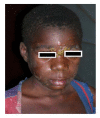Clinical outcome of skin yaws lesions after treatment with benzathinebenzylpenicillin in a pygmy population in Lobaye, Central African Republic
- PMID: 22171605
- PMCID: PMC3309964
- DOI: 10.1186/1756-0500-4-543
Clinical outcome of skin yaws lesions after treatment with benzathinebenzylpenicillin in a pygmy population in Lobaye, Central African Republic
Abstract
Background: Yaws is a bacterial skin and bone infectious disease caused by Treponema pallidum pertenue. It is endemic, particularly among pygmies in Central African Republic. To assess the clinical cure rate after treatment with benzathinepenicillin in this population, we conducted a cohort survey of 243 patients in the Lobaye region.
Findings and conclusion: The rate of healing of lesions after 5 months was 95.9%. This relatively satisfactory level of therapeutic response implies that yaws could be controlled in the Central African Republic. Thus, reinforcement of the management of new cases and of contacts is suggested.
Figures




Similar articles
-
Yaws in Pygmy and Bantu children inhabiting the rural zones of Central Africa.Postepy Dermatol Alergol. 2022 Oct;39(5):887-892. doi: 10.5114/ada.2021.109604. Epub 2021 Oct 4. Postepy Dermatol Alergol. 2022. PMID: 36457685 Free PMC article.
-
[Resurgence of yaws in Central African Republic. Role of the Pygmy population as a reservoir of the virus].Bull Soc Pathol Exot. 1992;85(5):342-6. Bull Soc Pathol Exot. 1992. PMID: 1292791 French.
-
Yaws in West Sumatra, Indonesia: clinical manifestations, serological findings and characterisation of new Treponema isolates by DNA probes.Eur J Clin Microbiol Infect Dis. 1991 Jan;10(1):12-9. doi: 10.1007/BF01967091. Eur J Clin Microbiol Infect Dis. 1991. PMID: 2009873
-
Yaws.Lancet. 2013 Mar 2;381(9868):763-73. doi: 10.1016/S0140-6736(12)62130-8. Epub 2013 Feb 13. Lancet. 2013. PMID: 23415015 Review.
-
Yaws, Haemophilus ducreyi, and Other Bacterial Causes of Cutaneous Ulcer Disease in the South Pacific Islands.Dermatol Clin. 2021 Jan;39(1):15-22. doi: 10.1016/j.det.2020.08.002. Epub 2020 Oct 31. Dermatol Clin. 2021. PMID: 33228858 Review.
Cited by
-
Prevalence and risk factors associated with Haemophilus ducreyi cutaneous ulcers in Cameroon.PLoS Negl Trop Dis. 2023 Dec 27;17(12):e0011553. doi: 10.1371/journal.pntd.0011553. eCollection 2023 Dec. PLoS Negl Trop Dis. 2023. PMID: 38150487 Free PMC article.
-
Prospecting for yaws in the Mbaïki Health District in the Central African Republic.Pan Afr Med J. 2023 Jul 12;45:121. doi: 10.11604/pamj.2023.45.121.34060. eCollection 2023. Pan Afr Med J. 2023. PMID: 37790147 Free PMC article.
-
Yaws in Pygmy and Bantu children inhabiting the rural zones of Central Africa.Postepy Dermatol Alergol. 2022 Oct;39(5):887-892. doi: 10.5114/ada.2021.109604. Epub 2021 Oct 4. Postepy Dermatol Alergol. 2022. PMID: 36457685 Free PMC article.
-
Mapping the epidemiology of yaws in the Solomon Islands: a cluster randomized survey.Am J Trop Med Hyg. 2015 Jan;92(1):129-133. doi: 10.4269/ajtmh.14-0438. Epub 2014 Nov 24. Am J Trop Med Hyg. 2015. PMID: 25422395 Free PMC article.
-
Yaws.Int J STD AIDS. 2015 Sep;26(10):696-703. doi: 10.1177/0956462414549036. Epub 2014 Sep 4. Int J STD AIDS. 2015. PMID: 25193248 Free PMC article. Review.
References
-
- WHO. Yaws: A forgotten disease. Fact sheet N°316, January 2007. 2007. accessed at http://www.who.int/mediacentre/factsheets/fs316/en/ on July 10, 2011. - PubMed
LinkOut - more resources
Full Text Sources

